 |
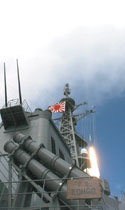 |
| In December, the Japan Maritime Self-Defense Force (JMSDF) destroyer Kongo successfully tracked and intercepted a target missile with the Aegis ballistic missile defense (BMD) system. The test marks the first time a U.S. ally has acquired the sea-based BMD capability. |
New capability provides security from hostile states, but challenges remain for coalition operations.
A key Pacific ally of the United States has become the first foreign nation to field a sea-based ballistic missile interception system. The technology is a modification of the Aegis air defense weapons system designed to track and destroy short- and intermediate-range missiles. This capability permits Japanese warships to defend their island nation from attack by neighboring states.
On December 18, 2007, the Japan Maritime Self-Defense Force (JMSDF) Aegis destroyer, the JDS Kongo, successfully acquired, tracked and intercepted a target missile launched from the Pacific Missile Range Test Facility in Hawaii. The Kongo fired a Standard Missile–3 (SM-3) Block 1A, which destroyed the target approximately three minutes later at an altitude of 100 miles over the Pacific Ocean. The event, designated Japan Flight Test Mission 1 (JFTM-1), was the first time that an allied vessel had successfully intercepted a ballistic missile with the Aegis Ballistic Missile Defense (BMD) system.
The BMD capability is revolutionary for the Japanese military, explains Rear Adm. Alan B. Hicks, USN, program director, Aegis ballistic missile defense program, Missile Defense Agency, Washington, D.C. “This mission area is so transformational that it changes how you see the world. Instead of just defending an area of a few hundred miles, you’re dealing with a whole country that spreads across time zones,” he says.
The JFTM-1 was the culmination of years of negotiations and high-level communications between both nations. By the mid-1990s, Japan had expressed a tentative interest in a missile defense capability, but little progress occurred until 1998 when North Korea test-launched a Taepodong ballistic missile over Japan. This act and ongoing international tension about North Korea’s nuclear weapons and delivery systems programs ultimately compelled the Japanese government to acquire a missile defense capability.
In 2006, the U.S. military installed a forward-based X-band radar system in northern Japan to provide early warning of a North Korean missile launch. Radar data is shared with both the U.S. and Japanese governments. Besides providing a long-range sensing capability, the radar also tracks and coordinates medium-range ship-based interceptors and short-range ground-based Patriot Advanced Capability-3 (PAC-3) missiles.
U.S. Navy officials note that both the U.S. and Japanese navies have an operational dialogue that extends from the four-star level down to individual ship commanders. The crews on U.S. and JMSDF Aegis BMD warships share common tactics, techniques and procedures, the officials said. The admiral adds that both the United States and its allies can share tactical data. But this information takes on a different meaning when large distances are involved and certain protocols are still being determined. Adm. Hicks believes that the process of sharing linked data between allied ships soon will be established. However, the issue of Japan aiding other nations with missile defense remains the larger challenge. “The issue of engagement is where it’s going to take a lot more time,” he says.
Although Japan can now defend itself, its ability to aid other nations is restricted by its post-World War II constitution, which prevents it from participating in collective defense. According to its constitution, Japan cannot intercept a missile that is not specifically directed at its territory. Adm. Hicks notes that the Japanese government is undergoing a national process to determine the parts of its constitution that must be changed to allow it greater military flexibility to help its allies. Japanese government officials declined to discuss sea-based BMD with SIGNAL Magazine, citing the delicate nature of the politics surrounding missile defense and the ongoing constitutional modifications.
The United States has a treaty in place to defend Japan and to support its defenses in the event of foreign aggression. The admiral explains that the main topic of discussion between the two governments is determining the decision-making processes for weapons release authority during a crisis. The admiral expects a command and control framework to be agreed upon over the coming months.
The new Japanese defensive capability also highlights the overall progress of the Aegis BMD program. Adm. Hicks notes that the U.S. Navy has fielded a new Aegis BMD baseline—baseline 3.6—that allows the system to conduct long-range radar search and tracking. This modification also permits Aegis-equipped ships to launch the SM-3 Block 1A missile.
Baseline 3.6 has two configurations. The first is a tracking and engagement version installed on 10 U.S. Navy ships, nine in the Pacific and one in the Atlantic. Seven more vessels are equipped with the radar search-and-track capability. By early 2009, Adm. Hicks expects these vessels and an additional ship to have the full tracking and engagement feature for a total of 18 ships. The SM-3 Block 1A missiles also are in production and are being delivered to the fleet. Besides the Kongo, three additional JMSDF warships will be BMD-capable by 2010.
Upgrading existing Aegis ships to BMD capability is a six- to eight-week process that can be done during a vessel’s regular maintenance overhauls. The modification process includes installation and verification testing of the software and systems and training of the crew with the new technology.
The program also is reaching a critical design phase for its next capability step, Aegis BMD 4.0. This capability matches with the next upgrade of the SM-3 missile, the SM-3 Block 1B. These upgrades will provide both navies with a more capable missile seeker, an upgraded maneuver system for the kinetic kill vehicle and more powerful computer processing. “It’s a significant enhancement in capability,” the admiral maintains.
 |
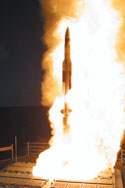 |
| The key part of the Aegis BMD weapons system is the Standard Missile-3 (SM-3) Block 1A (r). The missile can intercept short- and medium-range ballistic missiles in mid-flight. The SM-3 uses a kinetic warhead that relies on an infrared sensor to home in on the target (top). The United States and Japan are developing an enhanced version of the SM-3 with greater speed and range. |
Aegis BMD 4.0 will be combined with new software to upgrade the Aegis SPY-1 phased-array radar significantly, permitting a greater sensor capability than is currently available. This upgraded system begins testing in 2009, followed by fielding to the fleet in late 2010 and early 2011.
The United States and Japan have conducted joint cooperative research programs on missile, radar and computer weapons system technologies since the late 1990s. An example of this development took place in April 2006 when both nations launched the Joint Cooperative Test One. This event consisted of the successful launch of an SM-3 Block 1A from the USS Lake Erie. This missile featured a Japanese-designed clamshell nose cone. The admiral explains that the current nose cone protecting the kill vehicle is ejected in space as a single piece. The Japanese-designed nose cone splits in half, allowing a larger warhead to deploy more quickly.
Under the Japanese Cooperative Development (JCP) program, the SM-3 Block 2A will be fielded in 2015. The current version of the SM-3 has a 21-inch first stage and 13-inch second and third stages. Each of the Block 2A missile’s stages will be 21-inches across. Known as the “full caliber round,” the larger stages will provide increased operational range, speed and room for more sensitive sensors and computers. The admiral notes that both the United States and Japan are developing the SM-3 Block 2A, with an even distribution of development funds.
The next significant upgrade to Aegis BMD will occur in the late 2010 time frame with the SM-3 1B missile and the upgrades to the system. This enhancement will include a BMD signal processor designed to provide Aegis-equipped ships with a synthetic wideband radar capability for greater target discrimination.
The new 21-inch SM-3 provides a number of advantages over the SM-3 Block 1A and Block 1B. The admiral notes that with the current missiles, several ships are required to defend Japan from missile attack. The Japanese military is particularly interested in the 21-inch missile because with it, one ship can cover most of the island chain.
For the United States, another capability of this longer range and faster missile is that it can intercept intermediate-range ballistic missiles with a range of 5,500 kilometers (3,417 miles). “That greatly increases what we can defend in battlespace,” the admiral shares.
The new missile also has the potential to counter some less sophisticated intercontinental ballistic missile (ICBM) attacks. But the admiral cautions that this is still a 21-inch missile and not a large ground-based interceptor. Although the SM-3 Block 2A is limited against ICBMs, Adm. Hicks believes this capability is a “game changer” because it greatly expands the area a single ship can defend against long-range threats. “It [the missile] will take us to the next level of thinking about how we employ and deploy the ships forward,” he says.
Using sea-based BMD capabilities in a coalition environment also fits into the U.S. Navy’s current maritime strategy. “If you’re going to operate forward, you’re going to have to operate in defense of allies, in defense of the sea base or to preserve maritime commerce. You cannot be held at risk from a threat that you do not have a capability to defend against,” the admiral says.
Admiral Hicks adds that this capacity is important for the United States and its allies. He notes that defensive coverage will be thin if the U.S. Navy has only 18 Aegis BMD-equipped ships until 2013. Meanwhile, some 80 Aegis air defense equipped ships in the fleet could be upgraded to the BMD role. The admiral is concerned about the United States’ flexibility to provide a missile defense capability when it is required. Besides the necessary number of ships, the U.S. Navy has only a limited number of missiles loaded on ships. Because of funding issues, SM-3 production is not at full capacity. “I have a capacity problem that I think the agency [the MDA], the Navy and the combatant commanders are going to be coming to grips with in the coming months. … Right now, I can’t fulfill all of my customer requirements,” he says.
Besides Japan, other countries have expressed interest in Aegis BMD. Adm. Hicks notes that the nations that have purchased Aegis systems are Norway, Spain, Australia, South Korea and Japan. At this time, however, Japan is the only nation that has acquired the BMD upgrade for Aegis. The United States has agreements to provide both Spain and Australia with technical information about BMD capabilities. Spain dispatched one of its Aegis-equipped destroyers to participate in a BMD test in 2007.
The U.S. is in discussions with the Netherlands, which does not operate Aegis radar but uses a compatible radar suite. A Dutch air defense frigate successfully tracked a missile during a test in 2006. Both Germany and Denmark also have ships equipped with this radar capability, and each nation has shown interest in Aegis BMD. The program also is working with NATO and the United Kingdom, which is exploring a BMD capability for its new Type 45 air defense frigates. “The Japanese test was a validation to other nations that it was technically possible to acquire, install and implement this capability successfully. So we also view that as a game changer as to how people perceive that capability,” says Adm. Hicks.
Web Resources
U.S. Missile Defense Agency: www.mda.gov
Japan Ministry of Defense: www.mod.go.jp/e
Joint Cooperation Marks International Missile Program The cutting edge of the U.S. Missile Defense Agency’s Aegis Ballistic Missile Defense (BMD) program is the Standard Missile–3 (SM-3). The latest version of this weapon will feature the results of combined Japanese and U.S. research and development. Manufactured by Raytheon Missile Systems, Tucson, Arizona, the SM-3 is a dedicated ballistic missile defense interceptor designed around a guided kinetic warhead. The weapon is currently operational and deployed aboard Aegis missile destroyers and cruisers as well as is now operational with the Japan Maritime Self-Defense Force (JMSDF). The SM-3 is a three-stage ship-launched rocket. Its first two stages are common to all the Standard Missile variants, the SM-2 Block 4 and the SM-6. But the SM-3 features a third-stage rocket motor to propel a missile out of the atmosphere. Protected by a nose cone, the kinetic kill vehicle is a small warhead weighing about 25 to 30 kilograms (55 to 60 pounds) that when deployed locates the target and destroys it by colliding with it at high speed. The kill vehicle is extremely accurate when homing in on a ballistic missile or re-entry vehicle, maintains Dean Gehr, director, business development for missile defense programs, at Raytheon Missile Systems. “We literally pick a point on the target and hit that point,” he says. Japanese involvement with the SM-3 program began in 1999 with a memorandum of understanding for a cooperative research effort that launched the U.S.-Japan Cooperative Research (JCR) program. Under the JCR program, the SM-3 Block 2A missile will integrate into ships deploying existing SM-3 Block 1A missiles and fit into the standard Mark 41 vertical launcher aboard Japanese and U.S. ships. Gehr explains that the main difference between the SM-3 variants is that the Block 2A missile retains the missile first stage as the Block 1A but features new second- and third-stage rocket motors that are larger in diameter. “It essentially fills up the full volume in that Mark 41 vertical launch canister,” Gehr says. By comparison, the SM-3 Block 1A is only 13 inches in diameter at its upper stages; the SM-3 Block 2A is 21 inches in diameter. Gehr notes that the larger size of the missile’s upper half permits the development of a larger kill vehicle. The new warhead will have a larger infrared seeker able to detect more sophisticated threats at greater ranges. The kill vehicle also will have a bigger propulsion/maneuver system, enabling it to pursue more agile threats. The increased engine size permits the missile to reach targets more quickly, and it allows a single ship to defend a much larger region, he says. After the Block 2A concept was developed, the United States and Japan examined component areas that required research and development. The areas selected for joint research were the missile’s clamshell nose cone, kill vehicle technology and a two-color infrared seeker. The final research area was the development of a larger second-stage propulsion system. These research tasks were split between the two nations with each responsible for developing certain components, he says. The clamshell nose cone and the 21-inch second-stage rocket motor were developed by Japan, while the U.S. developed the advanced propulsion system for the kill vehicle. Both nations combined their efforts on the advanced infrared seekers. In 2006-2007 the JCR transitioned from a research to a development program. A new memorandum of understanding was signed for the SM-3 Block 2A cooperative development effort. Jointly funded by both nations, initial flight tests for the SM-3 Block 2A are scheduled for 2010-2011 with full operational and production capability planned for 2014-2015. Once the missile is launched, it maintains communication with the ship throughout most of its flight until the kill vehicle separates from the missile. Both Block 1A and Block 2A kill vehicles transmit full video of the target back to the ship. The missile also is capable of mid-course correction. By the end of 2008, Gehr expects roughly 50 SM-3 1B missiles to be in the fleet. |




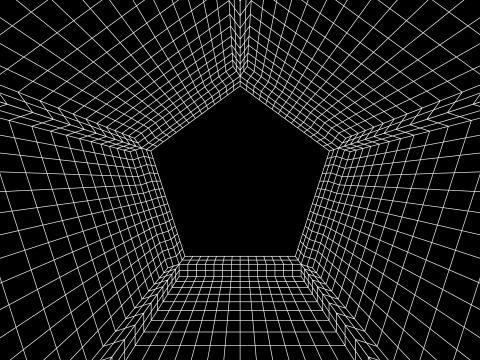
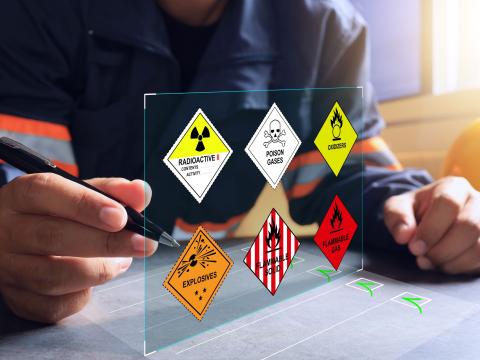

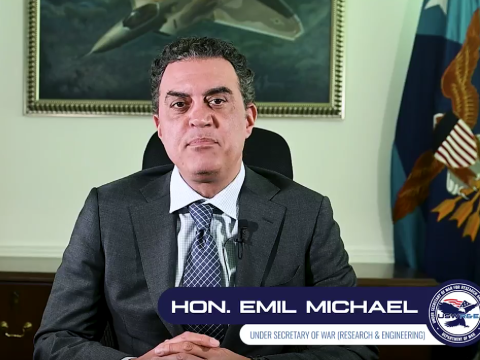
Comments